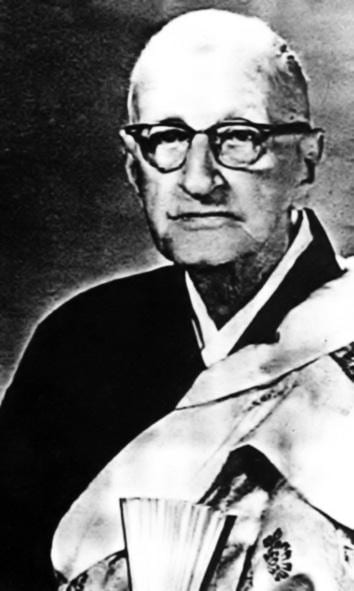About
Ernest Shinkaku Hunt (1876-1968), one of several almost forgotten early pioneers of Soto Zen Buddhism in the West ...
~~~
(translated from a biography in Vietnamese, combined with a short biography in English)
https://thuvienhoasen.org/a9737/ven-...hunt-1876-1967
https://www.patheos.com/blogs/monkey...ming-west.html
Rev. Ernest Hunt was born on August 16, 1876 in Hoddesdon, County Hertford (England). First, Hunt attended St. Pauls in London after graduating from Eastbourne College in Sussex. From an early age he was interested in learning about religions. At first he wanted to join the Anglican Orders, and studied for the Anglican priesthood, but eventually changed his mind and turned to Buddhism. This action made his parents extremely surprised and upset.
As a lieutenant with the British Mercantile Marine, Hunt had the opportunity to meet an Indian Buddhist sailor who recommended him to read several books on the theory of karma and Reincarnation, which helped Hunt admire Buddhism. He was attracted to the Buddhist teachings of Wisdom and Compassion ... In 1915, Hunt went to Hawaii to work as a bookkeeper for the Waipahu Plantation in Oahu, a sugar plantation.
Ernest was an avid student of the Buddha dharma and eventually received a degree from the Burma Buddhist Mission. Dorothy was also deeply investigating the great matter. Sadly, the sexism of the era and the lack of documentation readily available online leaves her more a shadow than a fully rounded figure. In truth today Ernest is only a bit better known.
Beginning in the 1920’s Ernest and Dorothy began teaching Buddhist religious education classes, mostly for the children of Japanese workers on the plantation. The theme was Buddhism and respect for the moral teachings of all religions. Within a few years nearly 13,000 children were registered in the various programs they’d established within the Honpa Hongwanji Shin Buddhist temple. In 1924 Ernest and Dorothy were both ordained priests within the Shin (Shin Pure Land) tradition. On August 11, 1924, in Hawaii for the first time in such a solemn ceremony, Hunt and his wife, Dorothy, were accepted by Rev. Imamura to become a new priest according to Japanese Mahayana Buddhism. From then, Hunt had the Dharma name of Shinkaku (Mindfulness). In 1926 Bishop Yemyo Imamura appointed Reverend Hunt as head of the English-language department. The initial plan was to reach out to people of Japanese descent. Quickly the Hunts began to reach out to people of European descent as well. The Reverends Hunt began to compose various hymns and other documents. Shinkaku first translated a book of ceremonies, and from there wrote various pamphlets on doctrine and other aspects of Buddhist teaching. This included a catechism for the Sunday school program. Among the notable features was how universalist his message was, usually not even mentioning the Shin school’s founder Shinran Shonen. In addition to guiding the masses, Rev. Shinkaku also often visited sick people in hospitals, prisoners in prisons as well as comforted those who are disabled, blind and suffering from incurable diseases. ...
In July 1928, about 60 Caucasians (from the south of Russia) began to want to learn about Buddhism and under the encouragement of Shinkaku, they founded an organization to spread the Buddha's teachings to Westerners. They also published a bulletin explaining why they had converted to Buddhism. They generally expressed that Buddhism is a religion of reason, compassion and tolerance consistent with the spirit of science. ...
During the Second World War, when Japanese monks were mostly imprisoned or isolated by local authorities, Shinkaku alone in Hawaii courageously stood up to find ways to protect the temples, and many Japanese Buddhists escaped discrimination, oppression and destruction by the US military as well as patriotic local American civilians. The Venerable Master often told the people and government officials on the island: " Our Buddhism has nothing to do with this war. ”
[Written by a Great Grandson: "One commentator observed that his Buddhism was more traditional Theravada. “His was a Buddhist humanism in which Shakyamuni was a wise teacher but not a god, and the Dharma was about love, charity, kindness, respect, service, gratitude, and poise.” Writing from a contemporary perspective, I’d say it was more “modernist,” and looking at the hymns particularly, I’d add in “theosophical” or maybe “New Age.” Digging a bit I found he in fact wrote a number of articles for the Occult Review. The titles for these articles suggest more than a passing interest in subjects ranging from hypnotism to spiritualism, as well as New Thought in general. ... " ]
Sadly Bishop Imamura died in 1952. His successor, Bishop Kuchiba Gikyo wanted a purer commitment to the Pure Land, and the Hunt’s broader, even universalist Buddhism seemed well off that mark. In 1953 Reverend Hunt’s project was disbanded by the new bishop. ... In 1952, after the death of Rev. Imamura, Rev. Shinkaku left the Shin Honganji temple to practice as a disciple of Rev. Zenkyo Komagata at the Soto Zen Temple in Honolulu. Here, Shinkaku was placed in charge of teaching the Buddha Dharma in English to tourists visiting Hawaii from Great Britain and the United States. During this time he wrote and published "Gleanings from Soto Zen" and "Buddhist Sermons."
In 1953 Shinkaku was ordained as an Osho by Rev. Komagata, who was also the Sotoshu Dokan, or Bishop for Hawaii. With this, Ernest Shinkaku Hunt became the first person of European descent to be ordained a full priest within the Soto school ... He spent much time in his last years in the Soto Temple, where he greeted the increasing number of tourists who were coming to the islands.
Shinkaku passed away in February 1968 in Hawaii, at the age of 90. There is little additional information about Dorothy, who died at age 97 in 1983.
A passage from "
Gleanings from Soto-Zen," written in 1954 by Shinkaku Hunt ...
Nine Bows, Jundo

stlah





 Reply With Quote
Reply With Quote












